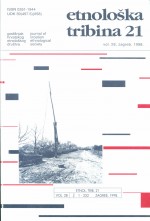Otarci i tkane slike
Otarci and Woven Pictures
Author(s): Tihana PetrovićContributor(s): Valentina Gulin Zrnić (Translator)
Subject(s): Fine Arts / Performing Arts, Customs / Folklore, Ethnohistory, Recent History (1900 till today), Cultural Anthropology / Ethnology, 19th Century
Published by: Hrvatsko etnološko društvo
Keywords: tradition of weaving; Slavonia;
Summary/Abstract: The author presents some data on the last weaver’s locality in the village of Vukojevci in the Našice region, Slavonia. The paper is divided into two parts. The first part, Otarci (towels) deals with weaving textile art in Vukojevci in the period between the First World War and the beginning of the Patriotic War in the 1990s. Only women weaved in the mentioned period of time, and the main product from the 1950s were wedding towels (otarci). The second part, woven pictures, brings data on the period 1991-1997, when a young men has joint to female weavers, called “the weaver” although traditionally men did not participate in weaving activities. “The weaver” makes ordered wedding towels, but he also tries to find his own expression in textile art. According to his own sketches he weaves woven pictures, as he calls them. That are usually emblems of clubs (football), army units and statures of Virgin Mary. He is not only weaving but he also makes his own textile basis. The author points to the peculiarities of this weaver’s locality but also to some of the reasons that influenced that weaving in Vukojevci has been maintained so long and persistently until present days. One of the main reasons is the exchange of towels on the occasions such as birth of a child, death or wedding. Furthermore, there are some economic factors: because of low purchasing power people cultivated flax and they weaved textile on their own until 1960s. Women sold weaved textile material on markets, and money earned in that way was considered their personal property (prćija). Informants stress another reason that maintained tradition of weaving and that is love and affinity for this activity. It seems that one more element was crucial: women from that region preferred weaving to embroidery. The appearance of a young man, “the weaver”, is based on a local weaving art, skill, tools and tradition that was held by women. At first he was working with his mother weaver, but became an expert who is searching for his own expressions in weaving. He is also an example of an individual changing the inherited tradition. At the end, the author compares her own research with the studies made by the ethnologist Zdenka Lechner in the paper “A female weaver on the Northeast Croatia” (1982). Lechner defined the existence of some weaving phases in three localities: Draž in Baranya, Stari Mikanovci in Slavonia and Bapska in Srijem. She also drew attention to the fact that the activity of weaving has been changing, being interrupted, even stopped and then emerging again depending on the circumstances and the way of life.
Journal: Etnološka tribina : Godišnjak Hrvatskog etnološkog društva
- Issue Year: 28/1998
- Issue No: 21
- Page Range: 109-120
- Page Count: 12
- Language: Croatian

